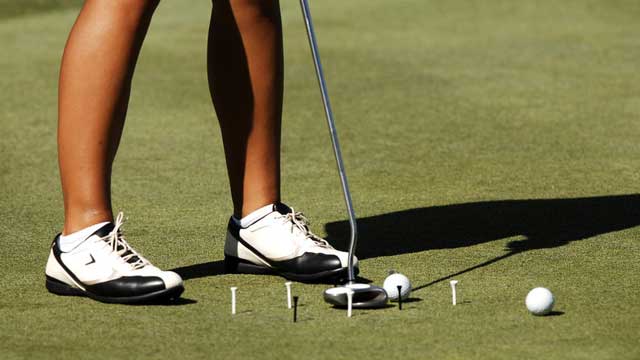NEWS
Basics of Putting

Harvey Penick once said: "A man who can't putt is a match for no one, a man who can is a match for anyone."
I think Harvey said it all. Putting is the easiest part of the game to practice. We all should be good putters. Practicing can be at home on the carpet, at the office between telephone calls, after school during study breaks and, of course, on the putting green. Here are the three best ways to practice (Note: directions are for right-handed golfers):
You must know your grip
Place your hands on the club with your palms facing each other. Allow the "lifeline" of your left hand to fit on the putter grip near the top of the handle. With the putter grip in the lifeline, this will help eliminate excess wrist movement. The back of the left hand and the palm of the right should face the target with your thumbs flat on top of the rubber grip. With the thumbs on top and the index finger under the shaft, you are able to gain touch. The more you practice this grip, the more touch you will have for your putts.
The fundamentals of putting
Make sure your grip is perfect. Aim your club face at your target and sole the putter head directly behind the ball. Position your eyes over the ball and down the target line. Set your shoulders, hips, knees and feet all parallel to the target line. Your hands should be directly under your shoulders and you should have a slight bend in your elbows. Ball position will be 2 inches inside your left heel and you should lean left with your weight. About 75 percent of your weight should be on your left heel. Your forearms must be parallel to each other, maintaining the same place throughout the stroke. As the putter starts away from the ball, the left shoulder will work down and the right will work up so that your shoulders control the stroke. Keep your head still while maintaining the angle in your right wrist throughout the stroke.
Strategic planning of the putt
"Plan your work, work your plan." Success or failure of every putt stems from preparation. When on the green, you must take time to read the putt. Reading or studying the putt will provide the logical information that will allow you to make a good putt. Determine if the putt is uphill or downhill, the amout of break (right or left turn), and how much speed you will need to be successful. The gathering of this information comes mainly from experience, which is gained by on-course situations, the practice putting green, and even on the carpet at home. The time spent reading the putt is the most important. Make your decision on how you are going to hit your putt, commit to it, and learn from it.
Here are two drills to assist you with putting:
Long putts ... the eye to the hole drill
Practice only putts 25 feet or longer. Use three balls. Read the putt, set up to the putt, and look up at the target while you make the stroke, looking at the target instead of the ball. This will help you focus on two things. First, thinking more about the target and less about the mechanics in your stroke. And second, rolling the ball the correct distance.
Short putts ... Listen, don't look drill
Practice putts within 6 feet and use three balls. Read the putt, set up to the ball, and keep your head still with your eyes in place while making the putt. Listen for the ball to fall in ... it's the best sound in golf. This drill will help in three ways: 1) Staying steady over short putts, 2) visualizing more clearly and 3) trusting yourself.
Remember, this is the fastest and easiest way to lower your scores. Life is too short for high scores.
